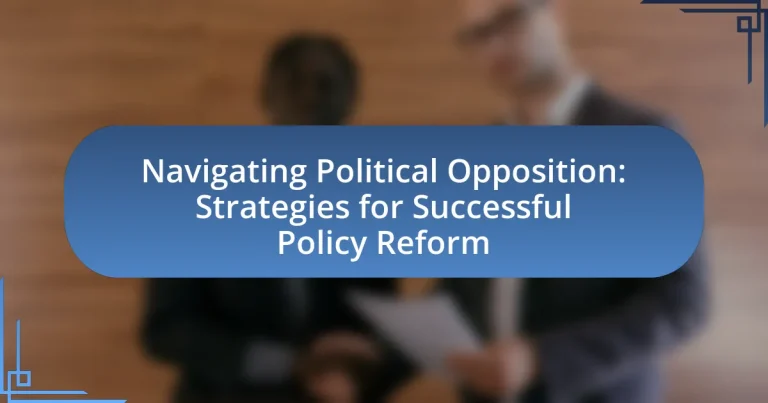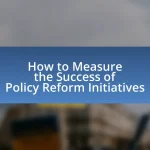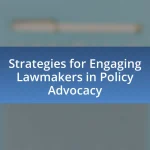The article focuses on navigating political opposition in the context of policy reform, highlighting key challenges such as entrenched ideological differences, lack of bipartisan support, and the influence of special interest groups. It examines how political opposition manifests through organized resistance, public dissent, and legislative obstruction, and identifies common sources of opposition, including interest groups and social movements. The article emphasizes the importance of understanding political ideologies and the impact of opposition on reform timelines, while offering strategies for effective navigation, such as coalition-building and proactive communication. Additionally, it discusses best practices for implementing successful reforms despite opposition, leveraging data, and maintaining resilience in the face of challenges.

What are the key challenges in navigating political opposition for policy reform?
The key challenges in navigating political opposition for policy reform include entrenched ideological differences, lack of bipartisan support, and the influence of special interest groups. Ideological differences often lead to polarized views, making it difficult to reach consensus on policy changes. For instance, in the United States, significant reforms such as healthcare and climate policy have faced opposition primarily due to differing political ideologies. Additionally, the absence of bipartisan support can stall legislative processes, as seen in the repeated failures to pass comprehensive immigration reform. Special interest groups further complicate the landscape by lobbying against reforms that threaten their interests, exemplified by the pharmaceutical industry’s resistance to drug pricing reforms. These challenges create a complex environment that requires strategic navigation to achieve successful policy reform.
How does political opposition manifest in the policy reform process?
Political opposition manifests in the policy reform process through organized resistance, public dissent, and legislative obstruction. Organized resistance often involves political parties or interest groups mobilizing to challenge proposed reforms, as seen in the U.S. healthcare debates where opposition parties utilized campaigns to sway public opinion against reforms. Public dissent can emerge through protests, media campaigns, and grassroots movements, exemplified by the widespread demonstrations against austerity measures in various European countries. Legislative obstruction occurs when opposition members use procedural tactics to delay or block reforms, such as filibusters in the U.S. Congress, which have been employed to stall significant policy changes. These manifestations illustrate how political opposition can significantly influence the trajectory and success of policy reform initiatives.
What are the common sources of political opposition?
Common sources of political opposition include interest groups, political parties, public opinion, and social movements. Interest groups often mobilize to advocate for specific policies that conflict with the interests of the ruling party or government. Political parties, particularly those in opposition, actively challenge the policies and actions of the governing body to gain electoral advantage. Public opinion can serve as a powerful source of opposition when citizens express dissatisfaction with government decisions, influencing policymakers to reconsider their positions. Social movements, driven by collective action around issues such as civil rights or environmental concerns, can also generate significant political opposition by rallying public support against existing policies. These sources are validated by numerous historical instances, such as the civil rights movement in the United States, which effectively opposed segregationist policies through organized activism and widespread public support.
How do political ideologies influence opposition to policy reform?
Political ideologies significantly influence opposition to policy reform by shaping the values and beliefs that individuals and groups hold regarding government intervention and social change. For instance, conservative ideologies often prioritize tradition and limited government, leading to resistance against reforms perceived as disruptive or overly progressive, such as healthcare expansion or environmental regulations. In contrast, liberal ideologies typically advocate for social justice and government action, which can result in opposition from conservative factions when reforms challenge established norms or economic interests. Historical examples include the backlash against the Affordable Care Act in 2010, where conservative groups mobilized against perceived government overreach, illustrating how ideological frameworks dictate the nature and intensity of opposition to policy changes.
Why is understanding political opposition crucial for successful policy reform?
Understanding political opposition is crucial for successful policy reform because it enables policymakers to anticipate resistance and tailor their strategies accordingly. By analyzing the motivations, concerns, and arguments of opposing factions, reformers can identify potential obstacles and develop counterarguments or compromises that address these issues. Historical examples, such as the Affordable Care Act in the United States, illustrate that failure to engage with political opposition can lead to significant setbacks, as seen in the initial backlash and subsequent modifications made to gain broader support. Therefore, comprehending the dynamics of political opposition not only facilitates smoother implementation of reforms but also enhances the likelihood of achieving long-term policy goals.
What impact does political opposition have on the reform timeline?
Political opposition significantly delays the reform timeline by creating obstacles in the legislative process. When opposing parties or factions resist proposed changes, they can stall discussions, block votes, and introduce amendments that complicate or dilute the original reform proposals. For instance, during the Affordable Care Act’s passage in 2010, intense political opposition led to prolonged debates and modifications, extending the timeline for implementation. This illustrates how political resistance can hinder timely reforms, ultimately affecting their effectiveness and public perception.
How can political opposition derail well-intentioned reforms?
Political opposition can derail well-intentioned reforms by mobilizing public dissent, obstructing legislative processes, and leveraging media narratives to undermine support. For instance, when the Affordable Care Act was introduced in the United States, significant political opposition led to widespread misinformation campaigns that fueled public skepticism, ultimately affecting its implementation and public perception. Additionally, opposition parties can use procedural tactics, such as filibusters or amendments, to delay or alter reform proposals, as seen in various budget negotiations where partisan disagreements stalled critical reforms. These actions demonstrate how political opposition can effectively disrupt the progress of reforms intended to benefit society.
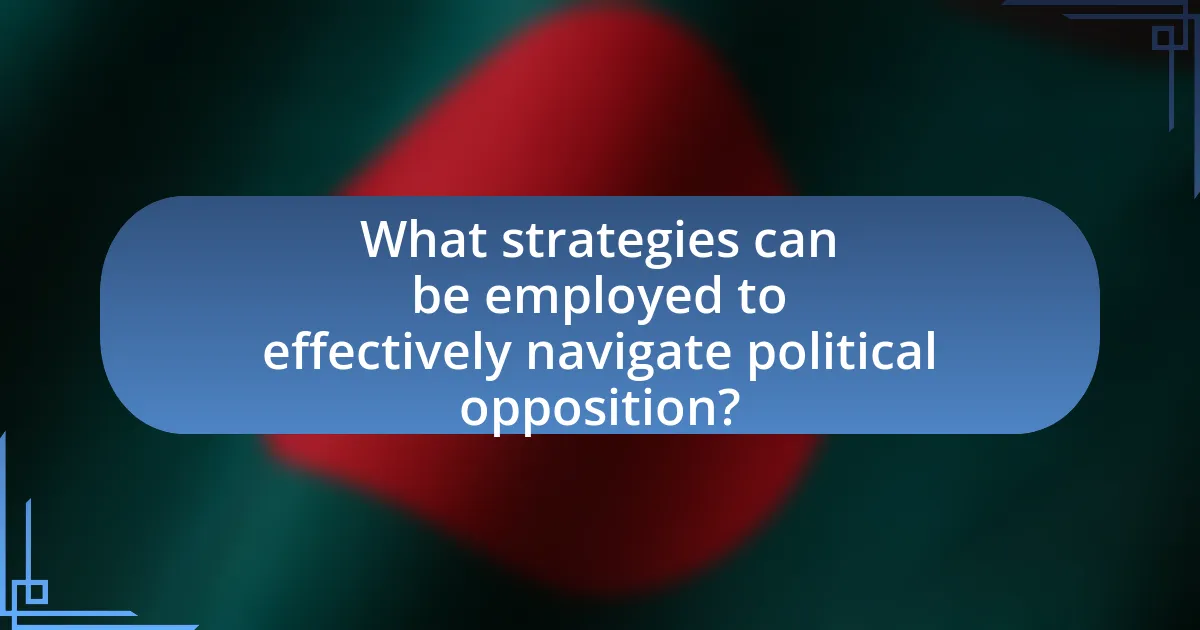
What strategies can be employed to effectively navigate political opposition?
To effectively navigate political opposition, building coalitions and fostering dialogue are essential strategies. Coalitions unite diverse stakeholders, enhancing influence and demonstrating broad support for initiatives. For instance, the Affordable Care Act’s passage in 2010 involved collaboration among various interest groups, which helped mitigate opposition. Additionally, fostering dialogue with opponents can lead to compromise and understanding, as seen in the bipartisan negotiations during the 2013 budget crisis, where open communication helped avert a government shutdown. These strategies not only address opposition but also create a more inclusive political environment, increasing the likelihood of successful policy reform.
How can coalition-building aid in overcoming political opposition?
Coalition-building aids in overcoming political opposition by uniting diverse groups to amplify their collective influence and resources. This strategic collaboration enables stakeholders to present a unified front, making it more challenging for opponents to dismiss or undermine their efforts. For instance, the passage of the Affordable Care Act in the United States was significantly bolstered by coalitions of healthcare providers, patient advocacy groups, and labor unions, which collectively advocated for reform and countered opposition. By pooling resources, sharing expertise, and coordinating messaging, coalitions can effectively mobilize public support and apply pressure on policymakers, thereby increasing the likelihood of successful policy reform despite political resistance.
What are the best practices for forming coalitions?
The best practices for forming coalitions include identifying common goals, engaging diverse stakeholders, establishing clear communication, and fostering trust among members. Identifying common goals ensures that all parties are aligned in their objectives, which is crucial for coalition effectiveness. Engaging diverse stakeholders brings in various perspectives and resources, enhancing the coalition’s capacity to address complex issues. Establishing clear communication channels facilitates transparency and collaboration, while fostering trust among members strengthens relationships and commitment to the coalition’s mission. Research indicates that successful coalitions often exhibit these characteristics, leading to more effective advocacy and policy reform outcomes.
How can diverse stakeholder engagement strengthen reform efforts?
Diverse stakeholder engagement strengthens reform efforts by incorporating a wide range of perspectives, which enhances the legitimacy and acceptance of proposed changes. Engaging various stakeholders, including community members, advocacy groups, and industry representatives, fosters collaboration and builds trust, making it easier to address concerns and mitigate opposition. Research indicates that inclusive processes lead to more effective policy outcomes; for example, a study by the World Bank found that stakeholder engagement in governance reforms significantly improved implementation success rates by up to 30%. This evidence demonstrates that when diverse voices are included, reforms are more likely to be comprehensive, equitable, and sustainable.
What role does communication play in addressing political opposition?
Communication plays a crucial role in addressing political opposition by facilitating dialogue, clarifying positions, and building consensus. Effective communication allows policymakers to articulate their goals and rationale, which can help mitigate misunderstandings and reduce resistance. For instance, during the Affordable Care Act debates, clear communication strategies were essential in addressing concerns and opposition from various stakeholders, ultimately leading to a more informed public discourse. Furthermore, studies indicate that transparent communication fosters trust, which is vital for overcoming political divides and achieving successful policy reform.
How can effective messaging counteract opposition narratives?
Effective messaging can counteract opposition narratives by clearly articulating the benefits and values of a policy while addressing misconceptions directly. For instance, when proponents of a policy communicate factual data and real-life examples that demonstrate positive outcomes, they can diminish the credibility of opposing claims. Research shows that campaigns utilizing fact-based messaging, such as the 2016 “Yes on 2” campaign for medical marijuana in Florida, effectively shifted public opinion by providing clear, relatable testimonials and statistics that countered negative narratives. This approach not only informs the audience but also builds trust, making it harder for opposition narratives to gain traction.
What communication strategies resonate with different political audiences?
Effective communication strategies that resonate with different political audiences include tailoring messages to align with their values, utilizing storytelling to create emotional connections, and employing data-driven arguments to establish credibility. For instance, conservative audiences often respond well to messages emphasizing tradition and personal responsibility, while progressive audiences may prefer narratives that highlight social justice and community impact. Research indicates that using relatable anecdotes can enhance engagement; a study by the Pew Research Center found that 65% of respondents felt more connected to political messages that included personal stories. Additionally, presenting statistics and factual evidence can appeal to audiences that prioritize logical reasoning, as demonstrated by a Gallup poll showing that 70% of voters value data-backed claims in political discourse.
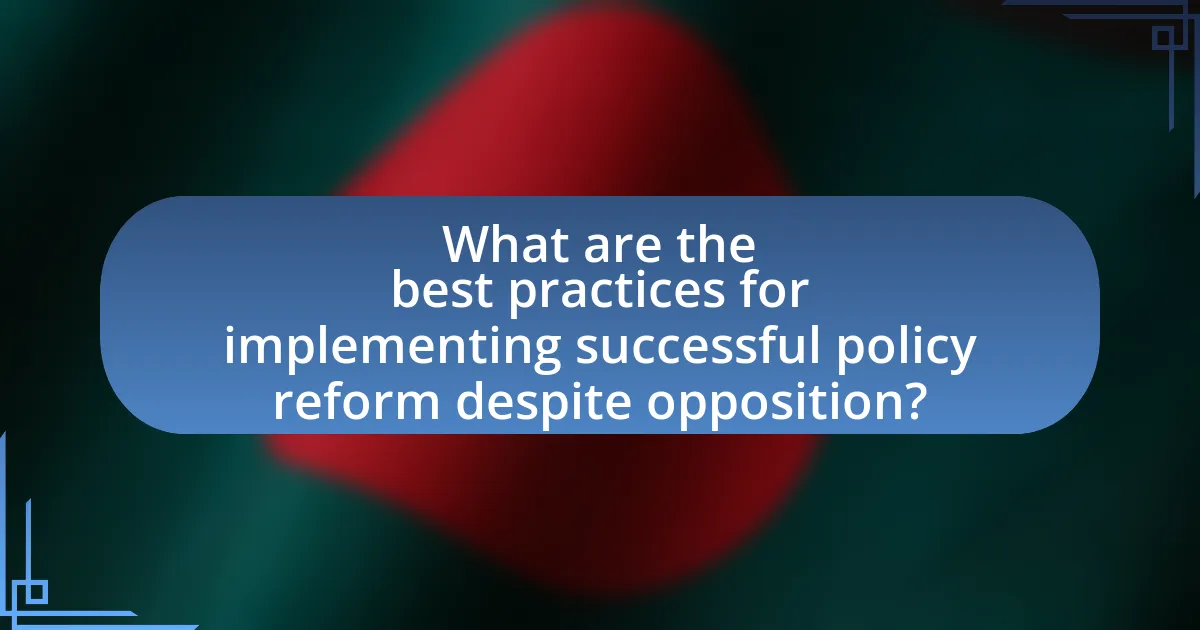
What are the best practices for implementing successful policy reform despite opposition?
The best practices for implementing successful policy reform despite opposition include building a broad coalition of support, engaging stakeholders early, and communicating effectively. Building a coalition ensures diverse perspectives and resources, which can strengthen the reform’s legitimacy and increase its chances of success. Engaging stakeholders early allows for addressing concerns and incorporating feedback, which can mitigate resistance. Effective communication is crucial; it involves clearly articulating the benefits of the reform and addressing misinformation. Historical examples, such as the Affordable Care Act in the United States, demonstrate that these strategies can lead to successful policy implementation even in the face of significant opposition.
How can policymakers leverage data and evidence to support reforms?
Policymakers can leverage data and evidence to support reforms by utilizing empirical research and statistical analysis to inform decision-making and justify policy changes. For instance, data-driven assessments can highlight the effectiveness of proposed reforms, demonstrating their potential impact on economic growth or social welfare. A study by the National Bureau of Economic Research found that evidence-based policy interventions can lead to a 20% increase in program effectiveness. By presenting clear, quantifiable outcomes, policymakers can build a compelling case that addresses concerns from stakeholders and mitigates political opposition.
What types of data are most persuasive in policy debates?
Quantitative data, such as statistics and empirical research findings, are the most persuasive types of data in policy debates. This is because quantitative data provides measurable evidence that can support claims and demonstrate the impact of policies. For instance, studies have shown that presenting statistical evidence, such as the correlation between increased funding for education and improved student outcomes, can significantly influence policymakers’ decisions. Additionally, data visualizations, like graphs and charts, enhance the clarity and impact of the information presented, making it easier for stakeholders to understand complex issues.
How can case studies of successful reforms be utilized?
Case studies of successful reforms can be utilized as practical examples to inform and guide future policy initiatives. By analyzing these case studies, policymakers can identify effective strategies, understand the context in which reforms succeeded, and adapt lessons learned to their own political environments. For instance, the implementation of healthcare reforms in countries like Canada and the UK demonstrates how comprehensive planning and stakeholder engagement can lead to successful outcomes. These examples provide concrete evidence that can persuade political opponents and stakeholders of the viability of proposed reforms, thereby reducing resistance and facilitating smoother implementation.
What practical tips can help navigate political opposition during policy reform?
To navigate political opposition during policy reform, stakeholders should engage in proactive communication and coalition-building. Proactive communication involves clearly articulating the benefits of the proposed policy to various stakeholders, addressing their concerns, and providing data-driven evidence to support the reform. For instance, research shows that inclusive dialogue can increase support by up to 30% among previously opposed groups. Coalition-building entails forming alliances with influential groups or individuals who share similar goals, thereby amplifying the reform’s visibility and credibility. Historical examples, such as the Affordable Care Act’s passage, demonstrate that strategic partnerships can significantly mitigate opposition.
How can policymakers maintain resilience in the face of opposition?
Policymakers can maintain resilience in the face of opposition by fostering open communication and building coalitions with diverse stakeholders. Open communication allows policymakers to understand the concerns of opposition groups, which can lead to more informed decision-making and potential compromises. Building coalitions with stakeholders, including community leaders and interest groups, strengthens support for policies and creates a united front against opposition. Research indicates that successful policy reforms often involve collaborative approaches, as seen in the implementation of healthcare reforms in various countries, where stakeholder engagement led to more sustainable outcomes.
What are the key lessons learned from past policy reform efforts?
Key lessons learned from past policy reform efforts include the importance of stakeholder engagement, the necessity of clear communication, and the need for adaptability. Stakeholder engagement ensures that diverse perspectives are considered, which can mitigate opposition; for instance, the Affordable Care Act’s success was partly due to extensive consultations with various interest groups. Clear communication helps to articulate the benefits and rationale behind reforms, as seen in New Zealand’s welfare reforms, which were effectively communicated to the public, leading to broader acceptance. Lastly, adaptability allows policymakers to respond to feedback and changing circumstances, exemplified by the gradual adjustments made during the implementation of the European Union’s Common Agricultural Policy, which evolved based on stakeholder input and economic conditions.
